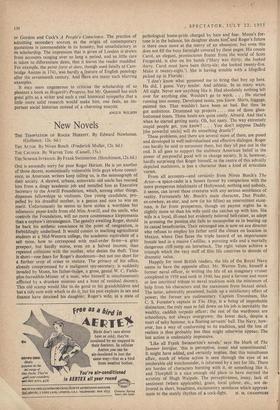Hogarth
HOGARTH'S PROGRESS. By Peter Quennell. (Collins, 25s.)
WILLIAM ,HOGARTH'S life story makes oddly dissatisfying reading. It was a success story that turned sour. His energy and talent soon pulled him out of the seedy, faded environment of his family home in Clerkenwell where his father just kept his head above water as a hack writer. He was thirty-five, however, by the time he achieved his full fame with the Harlot's Progress, the first of his great conversation pieces. The Rake's Progress followed three years later in 1735. His name and independence were assured. The last of the famous sets of engravings, Marriage a la Mode, appeared in 1745. Although he was to paint many fine portraits and producetsome brilliant cartoons after this date, he died in 1764 a disappointed and embittered man. There were many reasons for this decline. Hogarth's greatest ambition was never achieved : influenced by the historical murals of his father-in- law, Sir James Thornhill, he wanted to raise English painting to the grand manner, to prove conclusively its superiority to the foreign painting he always despised. His talent was entirely un- suited to the task, and his great religious canvases were passed over with tepid comment. He rushed into print with a work on aesthetics, The. Analysis of Beauty, to defend his dogmatic views. which was original rather than inspired, and was met with laughter. He took to political caricature and unwisely chose as his opponents Wilkes and Charles Churchill. He was, in short, a dogmatising, touchy, argumentative, narrow-minded man of genius. Mr. Quennell is masterly in his treatment of such a character, at once clear-sighted and sympathetic, but he cannot disguise the fact that Hogarth is entirely uninteresting apart from his work.
Hogarth's Progress, then, is an autobiographical string on which to tie two themes—Hogarth's work, and London in the first half of the eighteenth century. The string is not strong enough to carry two such heavy weights. Mr. Quennell's descrip- tions of the engravings are delightful, catching and revealing much that would escape less sharp eyes. Nevertheless, I cannot feel that descriptions of conversation pieces or portraits can really replace reproductions. This part of the book would have appeared better as a lavish collection of reproductions with Mr. Quennell's excellent text to accompany them. The London theme of the book I am less happy about. It is always a delight to-read Mr. Quennell's prose. At once elegant and strong, it is some of the best English that is written today. Nevertheless, the picture of London that he gives, though vivid, is far too impressionistic to satisfy. He cites the Burney collection in his bibliography, yet I cannot feel that he has made any serious attack upon its rich storehouse of social fact. Indeed, such quotations from news- papers as he makes are referred to as quotations from secondary sources—modern works like Phillips's The Thames about 1750 or Gordon and Cock's A People's Conscience. The practice of admitting secondary sources as the origin of contemporary quotations is commendable in its honesty, but unsatisfactory in its scholarship. The impression that is given of London is. drawn from accounts ranging over so long a period, and so little Care is taken to differentiate dates, that it leaves the reader muddled For example, the peine forte et dure, though used fatally at Cam- bridge Assizes in 1741, was hardly a feature of English penology after the seventeenth century. And there are many such blurring examples.
It may seem ungenerous to criticise the scholarship of so pleasant a book as Hogarth's Progress, but Mr. Quennell has such great gifts as a writer and such a real historical sympathy that a little more solid research would make him, one feels, an im- portant social historian instead of a charming essayist.
ANGUS WILSON



















































 Previous page
Previous page